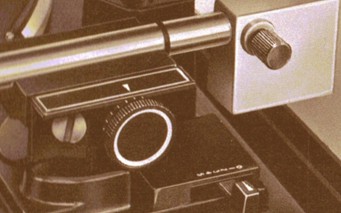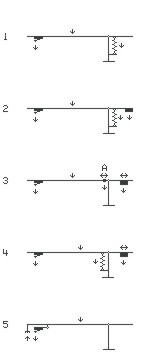 Finding the Pickup Arm Adjustments
Finding the Pickup Arm AdjustmentsThere are five different kinds of pickup arm:
Note that the arm will need to be set up again each time you change cartridges, plug-in heads, or the stylus force.
You will need a stylus force gage.
Always find out the specifications of the cartridge/stylus combination before making these adjustments and stay within these limits.
 Finding the Pickup Arm Adjustments
Finding the Pickup Arm AdjustmentsHere are the adjustments on a pickup arm:
Too many amateurs take the arm bearings apart, and then find out that they can't put them back together again. This is usually a mistake. Unless there is something wrong with the arm bearing itself, taking it apart does not provide any access to cure other problems.
 Adjusting the Stylus Force:
Adjusting the Stylus Force:The spring reduces the weight of the arm and cartridge down to the tracking force.
Use this procedure:
The spring and counterweight reduce the weight of the arm and cartridge down to the tracking force.
Use this procedure:
The counterweight reduces the weight of the arm and cartridge down to the tracking force. A second weight (A) can be used to apply tracking force.
Use this procedure:
The counterweight balances out the weight of the arm and cartridge down to zero.
The spring applies the exact tracking force.
Use this procedure:
The pad rides the record surface and holds up the entire weight of the arm.
The weight of the cartridge applies the tracking force.
This system usually cannot be adjusted. It is set for the correct force when the correct cartridge is installed.
Usually the stylus force gage also can't be used in the usual way.
The problem is what to do if the correct cartridge becomes unavailable:
There are seven different kinds of antiskate:
The actual antiskate force is about 1/10 the tracking force, but varies with stylus type.
If there is a calibrated scale, it is in units of stylus force, not antiskating force. Set it to the same value as the tracking force (and it does the math of setting the antiskate force).
If there are 2 or 3 scales, the first one is for conical styli, the second is for elliptical styli, and the third (if any) is for Shibata styli. Follow the instructions in the manual.
The elliptical antiskating force is about 1.125 times the conical antiskating force, and the Shibata antiskating force is about 1.28 times the conical force.
Record material also affects skating forces. Shellac has less skating force than vinyl. Polystyrene has more skating force than vinyl.
Since there is no antiskate, it cannot be adjusted.
There are several slots in the holder the thread is looped over. Selecting the slot adjusts the antiskate.
Since the antiskate is fixed, it cannot be adjusted.
Adjusting the weight adjusts the antiskate.
Adjusting the spring adjusts the antiskate.
The antiskate compensates for the skating of the tracking pad, so it is fixed. The pickup follows the tracking pad.
Since a linear tracking arm does not skate, it needs no antiskate.
If you have no instructions or there are no marks on the antiskate, a good guide is the centering of the stylus on the cartridge. If it deviates toward the spindle or toward the record rim when the stylus sets down in the groove, the antiskate is out of adjustment.
There are three different kinds of overhang and offset angle adjustments:
When there is no adjustment for overhang or offset angle, the judgment of the people who designed the arm and the cartridge must be trusted.
Usually the marker of the arm provides a plastic overhang guide to use to adjust the overhang.
If the arm has both the overhang and offset angle adjustments or is mounted separately, the math for the adjustments and a diagram may be provided.
The overhang on a linear tracking arm is always zero.
Check the tracking force adjustments after adjusting overhang or offset angle.
There are several different places adjustment for vertical angle can be found:
There is no adjustment. The vertical angle is set by the cartridge mount.
Adjust the height of the pivots so the vertical angle is correct.
On the Dual 1229, a lever has two positions for vertical angle, one for a single record and one for a stack of records.
Shims can be used to space the pickup closer or farther from the top of the arm, and to tilt it forward or back.
Perpetuum Ebner had an adjustment knob on the headshell for vertical angle. It was set to 1 for a single record, or to half the number of records in a stack.
Check the tracking force adjustments after changing shims.
There are several different places where the arm raising height adjustments can be found:
The adjustment may not exist. If it does, adjust it so the stylus can lower enough to play the record.
Adjust the height so the arm will lower enough to play the record, and so the arm does not hit the bottom of the stack when changing records.
Adjust the height so the arm will lower enough to play the record, so the arm does not hit the bottom of the stack when swinging out, and so the arm feeler touches the side of the stack for record size.
Adjust the height so the arm will lower enough to play the record, and so the arm feeler touches the underside of the stack to scan for record size.
There are several different places where the arm setdown position adjustments can be found. It is usually in the form of a screw or a cam:
Adjusting one size will affect all sizes equally.
This adjustment does not exist.
Adjust the setdown for any one record size. Repeatedly check and adjust it until it is correct. Then check the other sizes.
Adjust the setdown with one record until it is correct. Then check it with other sizes.
The screw in the headshell adjusts the position of the feeler. Adjust the screw so the stylus sets in the proper place on the record.